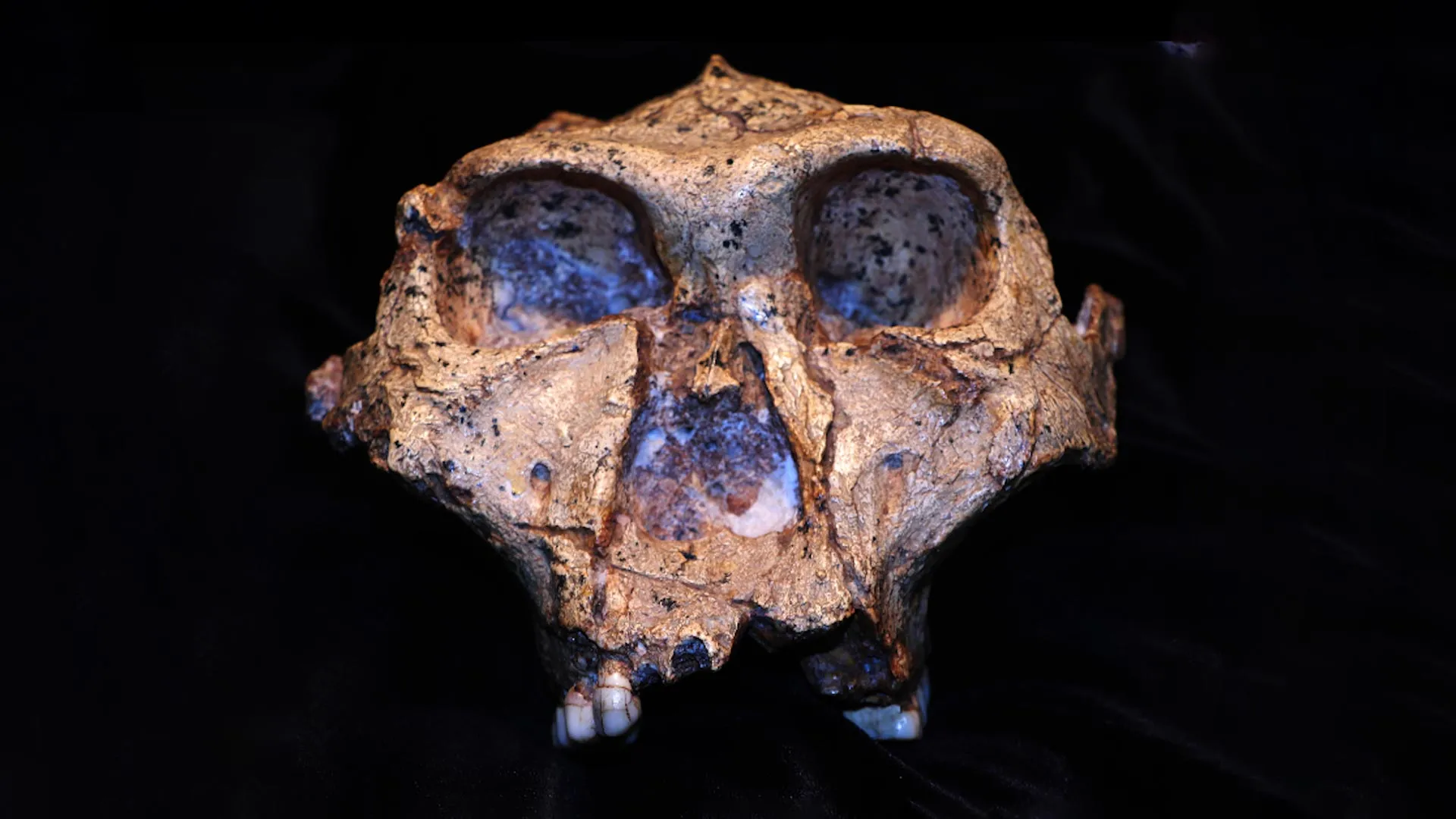2 million-year-old teeth reveal secrets from the dawn of humanity
Ancient proteins from Paranthropus robustus teeth revealed unexpected genetic diversity, reshaping how scientists view this early human relative.
- Date:
- November 1, 2025
- Source:
- The Conversation
- Summary:
- For decades, Paranthropus robustus has intrigued scientists as a powerful, big-jawed cousin of early humans. Now, thanks to ancient protein analysis, researchers have cracked open new secrets hidden in 2-million-year-old tooth enamel. These proteins revealed both sex and subtle genetic differences among fossils, suggesting Paranthropus might not have been one species but a more complex evolutionary mix.
- Share:

For nearly 100 years, scientists have been intrigued by the fossils of Paranthropus robustus, a sturdy, distant cousin of early humans. This upright-walking hominin was built for chewing tough foods, equipped with powerful jaws and large teeth coated in thick enamel. Researchers believe it lived in southern Africa between 2.25 million and 1.7 million years ago.
South Africa's fossil record preserves an extraordinary range of early human relatives. These include Australopithecus prometheus, A. africanus (best known for the Taung child), A. sediba, and P. robustus. Later species such as Homo habilis, Homo erectus/ergaster, Homo naledi, and ultimately Homo sapiens (modern humans) also appear in the record.
These fossils reveal key milestones in our evolutionary journey -- from walking on two legs to crafting tools and developing larger brains. Over time, this lineage led to the emergence of Homo sapiens in South Africa roughly 153,000 years ago.
Decades of Questions
When P. robustus fossils were first unearthed in 1938, they raised questions that persisted for generations. How much variation existed within this species? Were size differences linked to biological sex or evidence of multiple species? What genetic traits set P. robustus apart from other early hominins and the first members of the Homo genus?
Researchers have long sought genetic clues to answer these questions, but ancient DNA does not survive well in Africa's warm climate. To overcome this limitation, a team of African and European scientists turned to a different method: paleoproteomics, the study of ancient proteins.
They successfully extracted proteins from the enamel of four P. robustus teeth found at Swartkrans Cave, part of South Africa's Cradle of Humankind. Unlike DNA, proteins can survive for millions of years because they bond tightly to bone and enamel, making them more resistant to heat and decay.
One of these ancient proteins revealed the sex of the fossils, showing that two of the individuals were male and two were female.
The Oldest Genetic Clues from Africa
This work marks a major step in human origins research. It provides some of the oldest molecular data ever recovered from Africa, allowing scientists to reexamine how early human relatives varied and how they might have been related to one another -- or even represented multiple species.
The protein sequences also revealed intriguing genetic differences. One gene, responsible for producing enamelin (a key enamel-forming protein), varied among the specimens. Two fossils shared an amino acid sequence found in humans, chimpanzees, and gorillas, while the others had a version so far unique to Paranthropus.
Even more remarkably, one fossil carried both variants of the amino acid. This provided the first-ever evidence of heterozygosity -- two versions of a gene -- preserved in proteins that are 2 million years old.
A More Complex Family Tree
Mutations in protein sequences can signal evolutionary divergence. What appeared at first to be a mutation exclusive to P. robustus turned out to vary among individuals of the same group. This suggests that P. robustus may not have been a single uniform species, but a mix of populations with different ancestries.
By combining molecular data with physical anatomy (morphology), scientists can now create a more detailed picture of early human relationships. Future work will involve analyzing enamel proteins from additional P. robustus fossils found at other South African sites to test these findings.
Protecting Africa's Fossil Legacy
The research team took great care to preserve these irreplaceable fossils, following strict South African regulations and minimizing the amount of material sampled. Local laboratories and African researchers played central roles throughout the project, ensuring that both the science and the benefits remained closely tied to the continent's heritage.
Conducting advanced molecular research in Africa on African fossils represents an important move toward transforming and decolonizing the field of paleontology. It strengthens local expertise, fosters equitable collaboration, and ensures discoveries continue to enrich the regions where they originate.
A New Blueprint for Human Origins Research
By merging molecular and morphological data, this study offers a new model for exploring ancient diversity among early hominins. The findings suggest our ancient family tree was more complex than previously thought -- and potentially far richer.
As techniques in paleoproteomics continue to advance, researchers expect more revelations about the distant ancestors who shaped the human story. For now, the Paranthropus robustus mystery has grown deeper, more intricate, and infinitely more fascinating.
(Jesper V. Olsen, Rebecca R. Ackermann and Enrico Cappellini were also the principal investigators on this project.)
Written by Palesa P. Madupe, Claire Koenig, and Ioannis Patramanis from the University of Copenhagen.
Story Source:
Materials provided by The Conversation. Original written by Palesa P. Madupe, Claire Koenig, and Ioannis Patramanis. Note: Content may be edited for style and length.
Cite This Page: